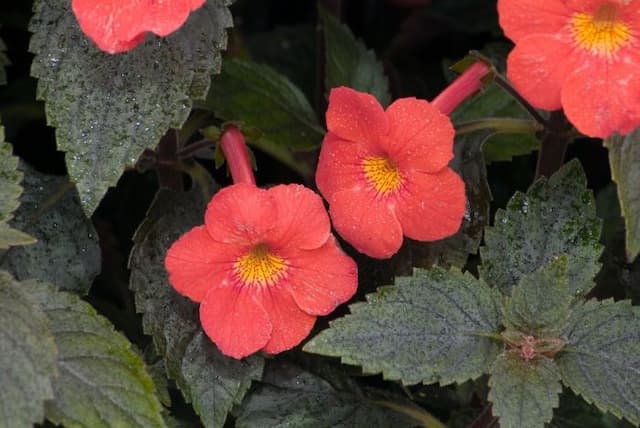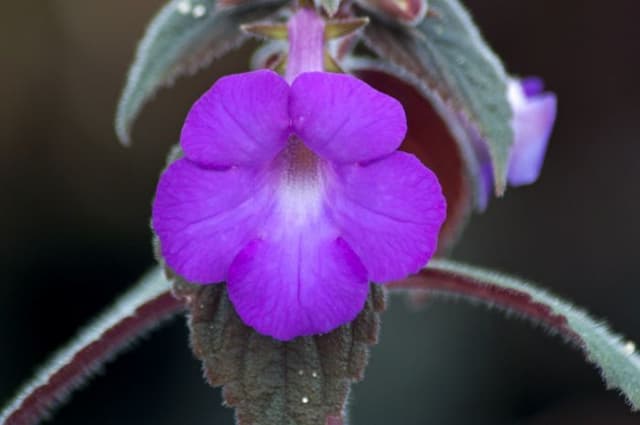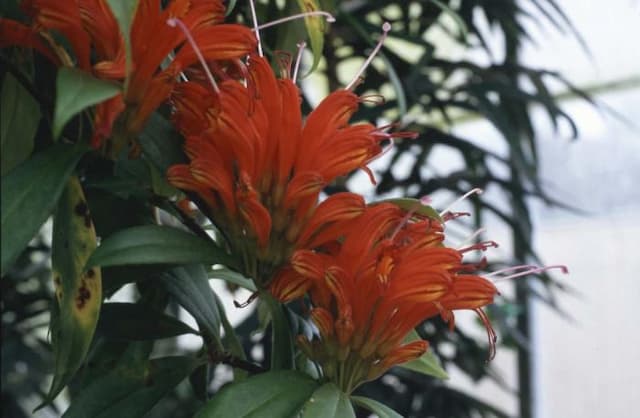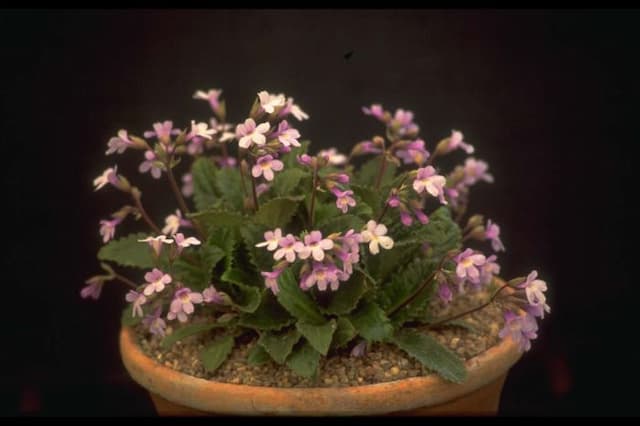Cape primrose 'Helen' Streptocarpus 'Helen'

ABOUT
'Helen' is a perennial forming a rosette of oblong, hairy leaves, with loose clusters of pale violet-blue flowers to 6cm across
About this plant
 Names
NamesFamily
Gesneriaceae
Synonyms
Cape Primrose, False African Violet
Common names
Streptocarpus 'Helen'.
 Characteristics
CharacteristicsLife cycle
Perennials
Foliage type
Evergreen
Color of leaves
Green
Flower color
Varies
Height
1 foot (30 cm)
Spread
1 foot (30 cm)
Plant type
Herb
Hardiness zones
10
Native area
Africa
Benefits
 General Benefits
General Benefits- Easy to Care For: Streptocarpus 'Helen' is relatively easy to maintain, suitable for gardeners of all levels.
- Long Blooming Period: It often produces flowers for extended periods, brightening up indoor spaces.
- Aesthetic Appeal: With its vibrant blooms and attractive foliage, it's a beautiful addition to any home or office decor.
- Compact Size: Its compact growth habit makes it suitable for small spaces or as a tabletop plant.
- Variety of Colors: The flowers come in various colors, providing options to match different tastes and decors.
- Versatile Plant: Suitable for planting in containers, hanging baskets, and as a houseplant.
- Mood Booster: The presence of flowering plants like Streptocarpus 'Helen' can improve mood and overall well-being.
 Medical Properties
Medical PropertiesThis plant is not used for medical purposes.
 Air-purifying Qualities
Air-purifying QualitiesThis plant is not specifically known for air purifying qualities.
 Other Uses
Other Uses- Plant Art: The Streptocarpus, also known as Cape primrose, can be used in botanical art due to its vibrant colors and interesting leaf patterns, which make it a great subject for watercolor or botanical illustration.
- Photography Subjects: Cape primroses offer photographers a chance to capture detailed macro photographs of their intricate flowers and velvety leaves.
- Educational Tools: These plants can be used in schools or educational programs to teach about plant biology, hybridization, and propagation techniques, due to the ease with which they can be grown and the clarity with which their reproductive parts can be studied.
- Gift Plants: With their long flowering season and attractiveness, Cape primroses are ideal as living gifts for occasions like housewarmings or as thank-you presents.
- Therapeutic Horticulture: Caring for Streptocarpus plants can be a form of relaxation and stress relief, offering therapeutic benefits to those involved in gardening activities.
- Collector’s Item: Plant enthusiasts and collectors may seek out rare or unusual varieties of Cape primrose to add to their plant collections.
- Perfumery: While not commonly used, the subtle fragrance of some Streptocarpus flowers could be an inspiration for creating unique botanical perfumes or scented candles.
- Modeling: Due to its attractive appearance, the Cape primrose can be used in interior design models or dollhouses as a miniature representation of larger garden plants.
- Color Inspiration: Artists and designers can take inspiration from the variety of colors found in the flowers and foliage of the Cape primrose for creating color palettes in art and design projects.
- Retirement Homes: Streptocarpus plants are easy to care for and can be a great addition to enhance the living spaces of retirement homes, offering residents a rewarding, low-maintenance gardening experience.
Interesting Facts
 Feng Shui
Feng ShuiThe Cape Primrose is not used in Feng Shui practice.
 Zodiac Sign Compitability
Zodiac Sign CompitabilityThe Cape Primrose is not used in astrology practice.
 Plant Symbolism
Plant Symbolism- Resilience: Streptocarpus, commonly known as Cape primrose, often symbolizes resilience due to its ability to thrive in shady and indoor environments with minimal care.
- Enduring Love: The long-lasting blooms of the Cape primrose can represent enduring affection, making it a suitable gift for showing lasting love and commitment.
- Adaptability: Symbolizing adaptability, Cape primrose reflects the capacity to adjust to various conditions, much like its ability to adapt to different lighting situations.
- Hope: As a plant that can bloom throughout the year, Cape primrose is often associated with hope and the continuity of life.
 Water
WaterCape Primrose should be watered when the top inch of soil feels dry to the touch. Use room temperature water and water the plant thoroughly, allowing excess water to drain out—aim to do this once a week. However, frequency may decrease to every other week during the winter months when the plant is not actively growing. Generally, use about 16 ounces of water for a 6-inch pot. Be careful not to let the plant sit in standing water to avoid root rot.
 Light
LightCape Primrose thrives in bright, indirect light. It should be placed in a spot where it can receive ample light but is shielded from harsh, direct sunlight. An east-facing or north-facing window would be ideal spots for this plant. Avoid placing it in full shade or overly dark areas, as this can lead to poor flowering and leggy growth.
 Temperature
TemperatureCape Primrose prefers temperatures between 60 and 80 degrees Fahrenheit but can tolerate a minimum of 50 degrees at night and a maximum of 85 degrees during the day. Keep the plant away from drafts and sudden temperature changes to prevent stress.
 Pruning
PruningPrune Cape Primrose to encourage bushier growth and more blooms. Remove spent flowers and yellowing leaves to maintain the plant’s vigor. The best time for pruning is after the plant has finished a major flush of blooms, which typically occurs in the spring or summer.
 Cleaning
CleaningAs needed
 Soil
SoilCape primrose prefers well-draining soil with a slightly acidic pH between 6.0 and 6.5. A recommended soil mix consists of one part peat moss, one part perlite, and one part loamy potting soil for optimal growth.
 Repotting
RepottingCape primroses should be repotted once a year, preferably in spring, to replenish nutrients and accommodate the growth of their roots. Older plants can be repotted less frequently if they seem comfortable.
 Humidity & Misting
Humidity & MistingCape primrose thrives best in moderate to high humidity levels, ideally between 50% and 60%. Keeping it in a well-humidified room or using a humidity tray can provide the right conditions.
 Suitable locations
Suitable locationsIndoor
Place in bright, indirect light and keep soil moist.
Outdoor
Protect from direct sun; water as topsoil dries.
Hardiness zone
10-11 USDA
 Life cycle
Life cycleStreptocarpus 'Helen', commonly known as Cape Primrose, starts its life as a seed, requiring warm temperatures and light for germination. Once sprouted, the seedling grows into a young plant with characteristic velvety leaves, during which it requires bright, indirect light and consistent moisture. As it matures, the plant enters a vegetative stage, producing larger leaves and beginning to form a rosette. The flowering stage follows, with Cape Primrose producing vibrant, trumpet-shaped flowers that can last several weeks with proper care. After pollination in some species, seeds can be produced, which may drop and potentially germinate nearby, propagating the cycle. Finally, as a perennial, Streptocarpus 'Helen' can enter a period of reduced growth, or dormancy, during cooler or drier conditions, resuming its growth cycle with the return of favourable conditions.
 Propogation
PropogationPropogation time
Spring-Early Summer
The most popular method for propagating the Cape primrose (Streptocarpus 'Helen') is leaf cuttings, which can be done at almost any time of the year but is most successful when the plant is actively growing, typically in the spring or summer. A healthy, mature leaf is selected, and a clean cut is made across the leaf, being sure to include a bit of the main stem if possible. The leaf is then laid flat on a moist potting mix and covered with plastic to maintain humidity. The leaf can be lightly scored in several places on the underside to encourage multiple plantlets. Roots will usually develop within a few weeks to a month, followed by the formation of small plantlets at the base or along the cut edge of the leaf. Once these plantlets have grown sufficiently to handle, typically when they are about an inch (2.54 centimeters) tall, they can be carefully separated and potted up as individual plants.









